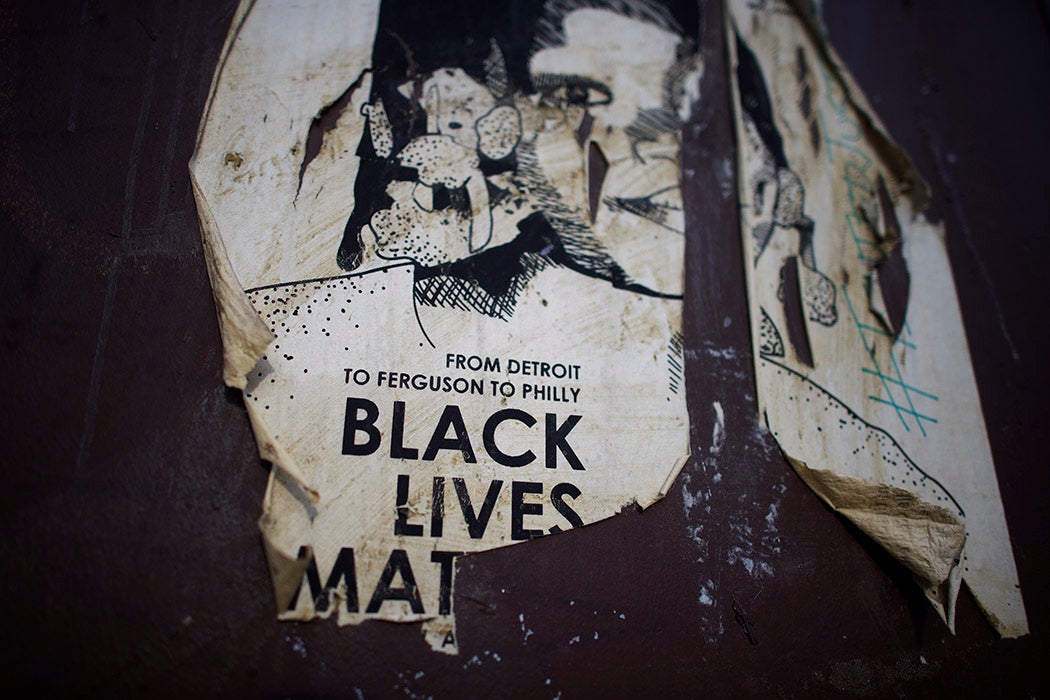It’s been over a year since Michael Brown’s death in Ferguson catapulted the Black Lives Matter movement and woke a generation of strong youth dedicated to critiquing and calling an end to police brutality. A year later, the tension and unrest between protesters and police fiercely continues.
After protests in 2014, many Ferguson stores had shattered windows that were later boarded up. Artist Damon Davis saw this as a pivotal and unique moment, taking to the streets of Ferguson with large mono print posters and buckets of glue made from flour and condensed milk. A mix of a city beautification project and a rallying cry of support, Davis’s #allhandsondeck project inspired store-owners, residents, and visitors alike as he transformed boarded-up windows into exhibition spaces for his monumental black and white photographs. Featuring images of different people’s hands raised with fingers spread wide in the memetic and symbolic “hands up, don’t shoot” gesture associated with the protests, the photographs welcomed residents back to their neighborhood stores, while offering simultaneously feelings of encouragement and solace.
Protest posters like Davis’s have a larger history, particularly because they are highly visible in public areas and, hence, are widely recognized and known. Los Angeles artist Robbie Conal made his name in the ’80s and ’90s by printing and posting his political posters around L.A. after midnight, under the cover of night.
As Steve Earle notes in his interview with Robbie Conal, the artist “is best known for unflattering drawings of political figures, which he reproduces in poster form and, with the help of nocturnal guerrilla postering crews, plasters directly in the eye line of America’s morning commute.” Readers might remember his “Contra Diction“ poster of Ronald Reagan from 1988 or his more recent series from the “Mandela Project,“ which was launched after Nelson Mandela died in 2013.
Though now a well-known Angeleno, activist, and artist, Conal and his work did not always have a large following. In Paul Von Blum’s article “New Visions, New Viewers, New Vehicles: Twentieth-Century Developments in North American Political Art,” he provides an overview of the rise of political art as a respected art form.
Von Blum asserts that “[a]rtworks focusing on critical views of politics and society have typically been marginalized, routinely dismissed as quaint, historically outmoded or merely topical.” However, beginning in the ’60s and carrying through to the present, political art has gained more and more recognition and traction. Part of this change, Von Blum argues, has to do with the messages fueling the artwork itself:
“The cumulative efforts of politically committed artists shed enormous if disconcerting light on the precariousness of existence in a technological world beset with overwhelming social, economic and environmental problems.”
Political posters prove to be a particularly effective medium for political art. Von Blum notes that “[f]rom the nineteenth century to the present, political posters have played a vital role in calling public attention to social injustice and to organizing political opposition and resistance.” As he sees it, Conal’s work was especially powerful precisely because of its public character, unlike art in museums, which only a select class of people often enjoy. Conal’s posters instead “constitute a political counterattack against the traditional mode of artistic creation and distribution in Western culture.”
With this non-traditional mode, political poster artists inundate everyday viewers with high-contrast images that inspire, instruct, and instill something quite out of the ordinary. It is in these unexpected moments that commuters become viewers and artists become inspirations.







